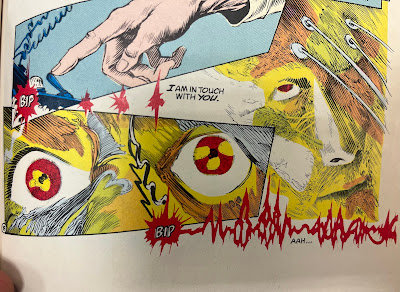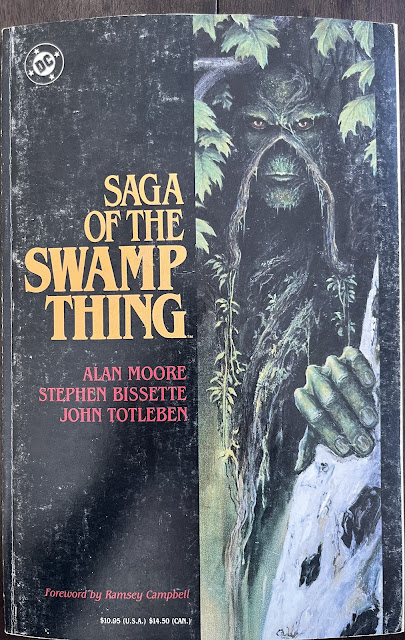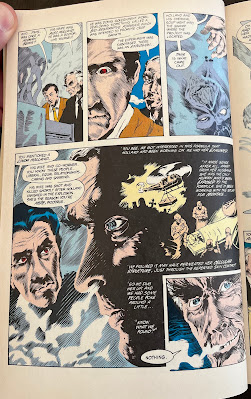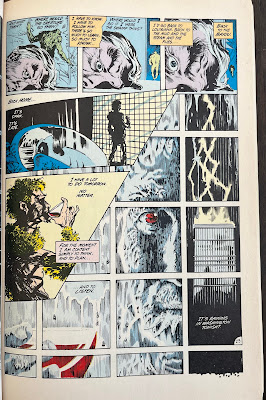A brief (re)introduction. Two friends of mine, Brad & Lisa Gullickson, hosts of the Comic Book Couples Counseling podcast, are doing a patreon exclusive issue by issue read-through of Alan Moore's Saga of the Swamp Thing, Gallivanting Through the Green. Always up for a re-read of Moore's Swamp Thing, I decided to use this as the impetus to return to writing, at least sporadically. I used to write about comics for a now defunct site, The Pulse, and also self-published some of those pieces, with some prose and comics work, in Warrio27: the Comics & Prose anthology, with my friend, Dan Fleming, and a host of great artists.
Alan Moore has been my favorite writer of comics -- and depending on the day, my favorite writer, period -- since I first read "The Anatomy Lesson," in the original Saga of the Swamp Thing trade paperback, back in 1987. This run, which I did not complete until years later, because DC did not fully collect it until even more years later -- between 2009-2011 -- has always held a special place in Moore's pantheon, for me, because it was the first of his works I read while also being one of the major runs of Moore's that I've read the least. For a long time, I've wanted to take a deep dive into this series, so that I could properly situate it in my mind, as far as where it stands in Moore's oeuvre. And this time seemed the best time for that.
So, here are some thoughts on the latest issue for the series, #22, "Swamped." I hope you enjoy.
Page 2:
This splash page is amazing! Abby & Matt, in searching for Swamp Thing, stumble across his comatose (is that the correct term for a being that is a plant?) body. He has rooted himself into the earth, become one with the green, and give up on life, because he now realizes that, though he contains the consciousness of Alec Holland he can never return to being human, because that is no longer what he is. Jason Woodrue came to that understanding in last issue's monumental story, and now, the Swamp Thing is no more.
But it's more than just the idea that is set up here. It is the art from Stephen Bissette & John Totleben. It's breathtaking. The way Swamp Thing's body is camouflaged in the broader foliage -- it's likely we readers would not have noticed without the startled reaction from Abby & Matt or the pooled water in his eye sockets and beneath his nose that are part of Swamp Thing's quite distinct profile. Then, once you realize what you're looking at, you can make out an arm (though one that is grown into the larger greenery), and his chest (with tubers pushing up from its surface). Then there's the Will Eisner-esque lettering, with 'Swamp Thing' formed by the moss hanging from a tree branch, and this issue's title 'Swamped' formed in the negative space around the algae pooling in the water beneath Swamp Thing's body. This is a high level of artistry.
Page 5:
Alan Moore loves wordplay, and he stabs at some of the low-hanging fruit for this issue's narrative when he has Jason Woodrue explain to Abby & Matt that Swamp Thing is "a vegetable." This description has two obvious meanings. First, Swamp Thing, as we discovered in the last issue, is a literal vegetable, a plant being that was infected with the human consciousness of Alec Holland rather than a human who'd been turned into a plant, as was previously believed within the world of this comic. Woodrue is also commenting on Swamp Thing's current emotional state of being, in that he has rooted himself into the earth, stopped reacting to stimuli, and become a vegetable -- in the human sense of the word -- because he has given up on living. He is comatose. A vegetable, as we colloquially call it.
Pages 7-8:
Half of this issue's narrative takes place within the dreamscape of Alec Holland, or Swamp Thing, and Moore tries to approximate how dreaming feels while still holding onto the narrative thread of the issue. One thing we all understand about dreams is the fact that, though we often know where we are within a dream, that setting -- elementary school, our home, a shopping mall -- never looks like the setting in real life, despite the certainty that our experiences are taking place within that very specific setting. Moore takes that juxtaposition and layers it with symbolism that stems from the Swamp Thing story up to this point. We start at Alec & Linda Holland's wedding reception, watch as Linda disappears into the ground and dies, see Alec given a mud-suit that is merely his Swamp Thing visage, which is then clawed away by Matt & Abby when they try to free Alec from suffocating, only to leave his empty legs as Abby ask, "Where's Alec?" the question haunting Swamp Thing throughout this issue.
Within this dream sequence, Moore really goes hard on the wordplay and word association. The hors d'oeuvres are made from planarian worms (a metaphor utilized by Woodrue to explain Alec Holland's consciousness entering the swamp's microorganisms); Abby mentions her uncle, Anton Arcane, is here, and Swamp Thing objects, stating he saw the body, that Arcane is dead, but Abby says, "...that was just a plant," (playing on two definitions of plant: the vegetation definition, which describes Alec Holland now, and the idea of a fake -- in this case, body -- 'planted' to turn people away from the truth); as Linda fades away, Alec says he will "...buy a restorative formula!" which is the chemical mixture that caused his consciousness to merge with the swamp plants; as well as the example of the mud-suit, noted in the paragraph above, and the query of "Where's Alec?" which is the narrative throughline of this entire issue.
Page 12-13:
More wordplay from Moore. When confronted by the giant planarian worms, who are the cooks offering "Eats!" at the top of page 12, and asked if he is Jewish, Swamp Things tells them no, "I come...from Holland." Which is true, Swamp Thing did come from Holland, Alec Holland, as Holland's consciousness, coupled with the restorative formula he created, is what animated the Swamp Thing. These "plain aryan worms" offer up a meal of the body of Alec Holland, and they tell Swamp Thing to eat up, "this stuff's real brain food!" which is an allusion to the fact that the swamp's microorganisms ate up the restorative formula plus the residual consciousness of the dying Alec Holland and crafted a creature that became known as the Swamp Thing. Then we get Swamp Thing stating that "...there's nothing left," when there is only a skeleton left. But the worms tell Swampy they've left him the best part, "...the humanity." And they tell him to "Try not to lose it." This is a rather direct metaphor for what has happened to Swamp Thing. He has lost his humanity, or any chance at retrieving his humanity as he'd always hoped, with the revelations from Dr. Woodrue. The skeleton of Alec Holland is an apt symbol of this humanity, and Swamp Thing discards his dead wife, Linda, in order to carry the skeleton with him through this dreamscape, an act that one could argue is an abdication of his humanity, of the empathy and compassion for others that is the highest representation of our humanity.
Page 14:
Abby's plea to Swamp Thing, to Alec, on this page is beautiful. She wants him to disregard the new evidence that Woodrue put forth in the last issue, she wants him to forget that he is only a plant, she doesn't care about any of that. Abby tells him, "...you are not a damn vegetable...You're human, Alec...you're the most loving, the most gentle, the most human man...that [she's] ever met." It is this idea of humanity -- the compassion, the empathy, the gentleness, the love -- that Abby holds more highly than any scientific ideas of genus and species. It is what's inside that makes the (hu)man, not what's on the outside.
There's another thing that Alan Moore is very good at, with regard to wordsmithing. He is able to utilize dialogue to get to the heart of a character. And at the bottom of this page, Moore shows that ability off with a bit of flair when Jason Woodrue expresses his happiness at Abby & Matt finally leaving and says to himself, "If there's one thing that I despise, it's the sound of steak sobbing." 'Steak sobbing,' is such a great phrase to use here. It shows Woodrue's prejudice against humanity and reinforces his desire to understand life from a plant's perspective.
Pages 19-20:
These two pages finish out Swamp Thing's dream sequence. He has become tired of the skull and bit of spine (all that is left of his humanity) always nagging him to keep moving keep running. It is the human race, an obvious play on words with race meaning species and race meaning a running competition. This idea of Swamp Thing's (Alec Holland's) metaphorical humanity nagging him to continue seeking what is completely lost finally beats the swamp monster down. He understands there is no resolution where he will regain that humanity. It's nagged at him for too long, now. So, in his dream, Swamp Thing gives up, lying down on the earth in order to root himself there, to no longer fight, no longer run, even as his physical body already has. It is final, Swamp Thing has given over to his new reality, and he does not wish to face it, so he just becomes part of the green.
Pages 21-22:
This two-page spread of Woodrue coming to the understanding, the overwhelming understanding, of what it means to be tied into the green -- that it means once is tied into every single fiber of vegetative life across the entire world, from giant Redwoods in California to the "teeming undergrowth of Africa," to a "yellow arctic poppy, up on the slope of Alaska," -- is a tour-de-force by artists Stephen Bissette & John Totleben & Tatjana Wood. The imagery, the colors, the franticness in the facial expressions, and the rending of his fake skin by Woodrue before he smashes through the window of his abode, is all brilliantly conceived and beautifully executed. It's the secret sauce that enhances the amazing writing from Moore and lifts Saga of the Swamp Thing to a new level of comic book greatness.
This is not an exhaustive analysis of what Moore & Company were doing in this issue, but it is what jumped out at me and piqued my interest. Some of it (much of it?) may be blatantly obvious, even to a first-time reader. But I hope you gleaned something interesting from my ramblings. And if there are other facets of this issue that intrigued you, share them in the comments. I'd like this to be a dialogue, and I'm always willing to learn more about the Mad Wizard of Northampton.
Until next time!
chris






















































